
Louis Vivin (born 28 July 1861, Hadol, France; died 28 May 1936 in Paris) was a French primitivist painter.

Louis Vivin (born 28 July 1861, Hadol, France; died 28 May 1936 in Paris) was a French primitivist painter.
Vivin was born in Hadol, France. He showed great enthusiasm for painting as a child, but his career took him in a completely different direction: until 1922 he worked for the mobile branch of the French postal service – "travel[ing] about the country a good deal, but always in a windowless railway mail car, lighted from above and walled by tiers of pigeonholes" [2] – pursuing his art only in his spare hours. [3] During this time he produced a series of maps showing the location of each post office in every postal district of France; this won him two years' seniority, the rank of inspector and the ribbon of the Palmes académiques , but the postal authorities decided that it would be too expensive to have the maps printed. [4]
In 1889 he moved to Paris, where he lived with his wife in a small fifth-floor flat – two rooms and kitchen – in the district of Montmartre. [5] [6] [7] He visited the Louvre and the Musée du Luxembourg: "The old masters left him unimpressed, but he liked Corot and Courbet, and fell in love with Meissonier. One night he had a vision: Meisoonier appeared in a dream and told him that he could be a great artist if he tried." [8]
Once he retired, on a pension, [9] in 1923, Vivin finally became a full-time artist. [10]
He was self-taught and a representative of naïve painting. Eventually, he was discovered by the German art critic Wilhelm Uhde (1874–1947), an association which helped him start exhibiting and build a reputation as a serious artist.
Towards the end of his life he had a stroke, followed by another, which affected his speech and left him unable to paint. He died, aged 75, on 28 May 1936, and was buried in the Cimetière parisien de Pantin. [11]
The subjects of Vivin's paintings were still life, hunting subjects, and the city of Paris, [12] and "illustrated books, magazine, loose flower prints, [and] chromolithographed picture postcards" were his models. [13] Vivin was a contemporary of Henri Rousseau, Camille Bombois, André Bauchant, and Séraphine Louis, known collectively as the "Sacred Heart Painters" and as masters of French naïve painting. [14] Vivin's works are known to have a sad and dismal theme to them. He was also known for painting from his memory. Louis Vivin was influenced by the work and details of Jean-Louis-Ernest Meissonier’s paintings. His works depicted genre scenes, flower pieces, hunting scenes and views of Paris, "notable for their charmingly wobbly perspective effects". [15]
Louis Vivin’s first one-man exhibition was placed at the Galerie des Quatre Chemins, and it was organized by Wilhelm Uhde in 1927. [10] His later work was considered to become less dependent of the melancholy mood, and it focused more on blocks of color and form. [5] [6]
Southampton City Art Gallery [16]
Auction Christie's [17]
Private collections [18]

Montmartre is a large hill in Paris's northern 18th arrondissement. It is 130 m (430 ft) high and gives its name to the surrounding district, part of the Right Bank. Montmartre is primarily known for its artistic history, for the white-domed Basilica of the Sacré-Cœur on its summit, and as a nightclub district.

Comte Henri Marie Raymond de Toulouse-Lautrec-Monfa, known as Toulouse-Lautrec, was a French painter, printmaker, draughtsman, caricaturist, and illustrator whose immersion in the colourful and theatrical life of Paris in the late 19th century allowed him to produce a collection of enticing, elegant, and provocative images of the sometimes decadent affairs of those times.

Naïve art is usually defined as visual art that is created by a person who lacks the formal education and training that a professional artist undergoes. When this aesthetic is emulated by a trained artist, the result is sometimes called primitivism, pseudo-naïve art, or faux naïve art.

The Basilica of Sacré Cœur de Montmartre, commonly known as Sacré-Cœur Basilica and often simply Sacré-Cœur, is a Catholic church and minor basilica in Paris dedicated to the Sacred Heart of Jesus. It was formally approved as a national historic monument by the National Commission of Patrimony and Architecture on December 8, 2022.

Jean-Baptiste Édouard Detaille was a French academic painter and military artist noted for his precision and realistic detail. He was regarded as the "semi-official artist of the French army".

Jean-Louis-Ernest Meissonier was a French academic painter and sculptor. He became famous for his depictions of Napoleon and his military sieges and manoeuvres in paintings acclaimed both for the artist's mastery of fine detail and his assiduous craftsmanship. The English art critic John Ruskin examined his work at length under a magnifying glass, "marvelling at Meissonier's manual dexterity and eye for fascinating minutiae." Meissonier enjoyed great success in his lifetime, becoming, with Gérôme and Cabanel, one of "the three most successful artists of the Second Empire."

Théophile Alexandre Steinlen, was a Swiss-born French Art Nouveau painter and printmaker. He was politically engaged and collaborated with anarchist and socialist press.

Sonia Delaunay was a French artist born to Jewish parents, who spent most of her working life in Paris. She was born in the Russian Empire, now Ukraine, and was formally trained in Russia and Germany, before moving to France and expanding her practice to include textile, fashion, and set design. She was part of the School of Paris and co-founded the Orphism art movement, noted for its use of strong colours and geometric shapes, with her husband Robert Delaunay and others. She was the first living female artist to have a retrospective exhibition at the Louvre in 1964, and in 1975 was named an officer of the French Legion of Honor.
Camille Bombois was a French naïve painter especially noted for paintings of circus scenes.
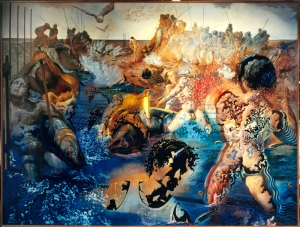
Tuna Fishing (Homage to Meissonier) was painted by Salvador Dalí in 1966–1967 and is seen by many as one of Dalí's last masterpieces.

Saint-Pierre de Montmartre is the second oldest surviving church in Paris, after the Abbey of Saint-Germain-des-Pres. It is one of the two main churches on Montmartre, the other being the more famous 19th-century Sacré-Cœur Basilica, just above it. Saint-Pierre de Montmartre, begun in 1133, was the church of the prestigious Montmartre Abbey, destroyed in the French Revolution.
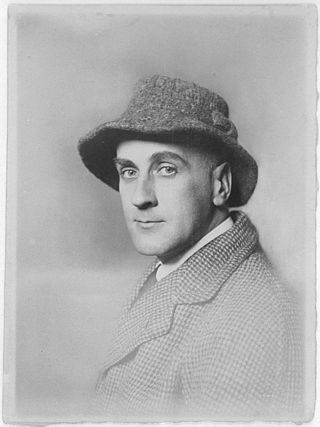
Wilhelm Uhde was a German art collector, dealer, author, and critic, an early collector of modernist painting, and a significant figure in the career of Henri Rousseau.

Séraphine Louis, known as Séraphine de Senlis, was a French painter in the Outsider art. Self-taught, she was inspired by her religious faith and by stained-glass church windows and other religious art. The intensity of her images, both in colour and replicative design, is sometimes interpreted as a reflection of her own psyche, walking a tightrope between ecstasy and mental illness.
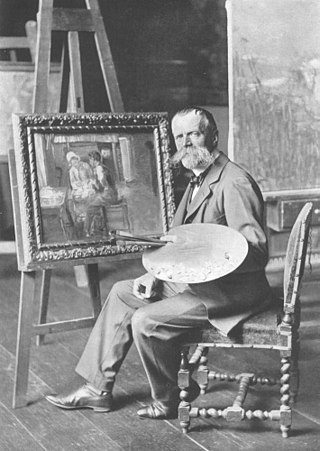
Fritz von Uhde was a German painter of genre and religious subjects. His style lay in-between Realism and Impressionism, he was once known as "Germany's outstanding impressionist" and he became one of the first painters to introduce plein-air painting in his country.
Jules Émile Élisée Maclet was a French Impressionist painter, particularly known for his views of Montmartre.
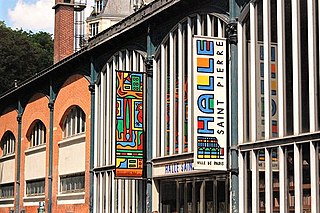
The Musée d'Art Naïf – Max Fourny, also known as the Musée d'Art Brut & Art Singulier, is a museum of naive art located in the Halle Saint-Pierre at 2, rue Ronsard, in the 18th arrondissement of Paris, France. The closest Paris Métro stations are Anvers on Line 2, and Abbesses on Line 12. It is open daily ; an admission fee is charged.

The Coronation of Napoleon is a painting completed in 1807 by Jacques-Louis David, the official painter of Napoleon, depicting the coronation of Napoleon at Notre-Dame de Paris. The oil painting has imposing dimensions – it is almost 10 metres (33 ft) wide by a little over 6 metres (20 ft) tall. The work is on display at the Louvre Museum in Paris.

La danse is an oil painting created circa 1906 by the French artist and theorist Jean Metzinger (1883–1956). Bacchante is a pre-Cubist or Proto-Cubist work executed in a highly personal Divisionist style during the height of the Fauve period. Bacchante was painted in Paris at a time when Metzinger and Robert Delaunay painted portraits of one another, exhibiting together at the Salon d'Automne and the Berthe Weill gallery. Bacchante was exhibited in Paris during the spring of 1907 at the Salon des Indépendants, along with Coucher de soleil and four other works by Metzinger.
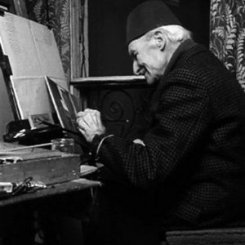
René Rimbert was a French painter. His work is often associated with Naïve art but has influences from Neorealism, Post- and Neo-Impressionism and Dutch Golden Age painting.

Joseph Stevens, birth name Edouard Joseph Léopold Stevens was a Belgian animalier painter and engraver. He is mainly known for his paintings with dogs as the principal subject. This included dog portraits, dogs interacting among themselves or with their masters and dog markets. From depicting sentimental scenes in a Romanticist manner his art developed towards a more Realist rendering of dogs living on the street or working for travelling entertainers. He won the admiration of the French realist painter Courbet for these efforts. He was a pioneer of Realism in Belgian art. He further painted horses and singeries, scenes with monkeys engaging in human activities. A few marines by his hand are also known.